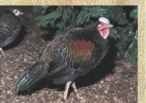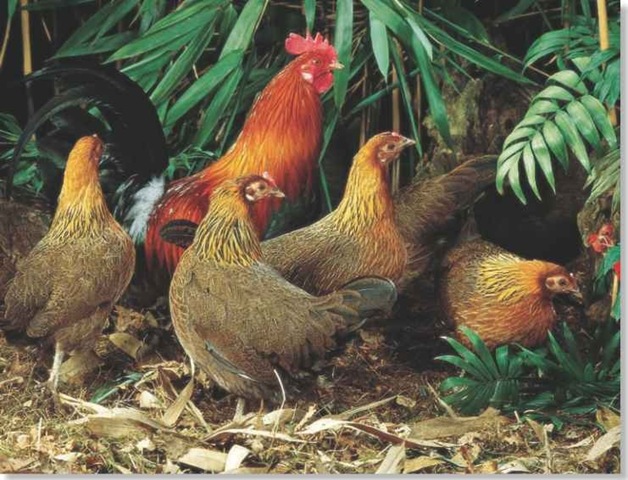ORDER
Galliformes
FAMILY
Phasianidae
GENUS & SPECIES
KEY FEATURES
The ancestor of domestic chickens, this colorful pheasant is a wild and wary bird
Lives under the rules of a group hierarchy established by ritual challenges and fighting Cross-breeding with domestic poultry is causing concern for the genetic purity of the species
WHERE IN THE WORLD?
Northeastern Pakistan and India east to southeastern China; south through the Malay Peninsula to islands of Sumatra, Java and Bali
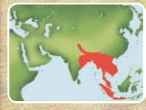
Lifecycle
For a shy bird, the red junglefowl has a loud claim to fame — as ancestor of the chicken, it is considered to be the most important species of bird in human history.
HABITAT
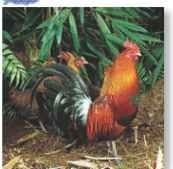
A Hiding place
A wary bird, the junglefowl never strays far from cover.
The red junglefowl is a bird of tropical and subtropical forests and woodlands, but prefers open woodland to dense jungle. It’s most at home at the edges of bamboo groves and in mixed woods with patches of cultivated land, especially wheat fields and rice paddies, where it can find plenty of food.
Usually found at altitudes below 3,000′, it lives up to 6,600′ in the Himalayas.
CONSERVATION
The red junglefowl has been hunted for centuries, but continues to exist in good numbers throughout most of its range and is not considered threatened. As a pure species, however, it may not be as common because it is almost impossible to determine how many free-living birds are genuine junglefowl rather than look-alikes that have resulted from matings with poultry. Destruction of forests in many parts of its range is a further concern.
The red junglefowl is fond of taking dust baths; it rubs itself in dry, sandy soil to remove parasites from its skin and feathers.
The domestic chicken — descendant of the red junglefowl — is the most abundant bird in the world, with a population exceeding a staggering eight billion. This outnumbers humans by about two billion.
BREEDING
During the breeding season, a male junglefowl assembles a harem of four or five hens, which he fiercely protects from rivals. He courts a female by dancing around her; hackles raised and fanning the wing nearest to her: After mating, the female builds a nest in some undergrowth from a scrape in the ground lined with dry leaves and grasses. She incubates her eggs for I 8-20 days.
The chicks run about within hours of hatching; at about a week old they are able to flutter up to a safe roosting perch. At first their mother passes food to them with her bill; although they can soon feed themselves, they don’t become independent until nearly 2 months old.
Oath of silence To avoid predators, hens never cluck while nesting.

RULING THE ROOST
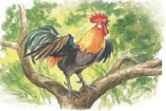
Rule…
A male red junglefowl crows loudly to proclaim his territory and assert ownership of a harem of hens.
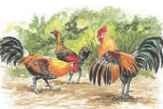
Raid…
A bachelor male attempts to take over the harem. The rivals square up to each other.
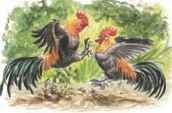
Ruckus…
Equal in size and splendor, neither cock is prepared to back down. They clash in a spur-slashing trial of strength.
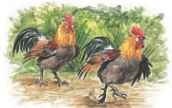
Run for it
The harem owner has won. With his dominance confirmed, he chases off the beaten bachelor.
FOOD & FEEDING
The red junglefowl is not a fussy eater, consuming whatever it finds on its feeding forays. Seeds and grain form the bulk of its diet, but it also takes fruit, shoots, insects and other small creatures, such as spiders, worms, snails and occasionally reptiles.The junglefowl does most of its feeding in the early morning and late afternoon, when it also visits streams and ponds to drink
Foraging in the same way as a chicken, the junglefowl scratches at the ground with its feet, scraping aside leaves and other debris to uncover edible morsels, such as seeds, fallen fruit and nuts.To get to succulent roots and tubers, it digs in the soil, and it takes berries, shoots and buds directly from plants.
The junglefowl must ►table for one also consume large up at dawn, the red junglefowl normally forages alone, although flocks occasionally gather to feed at prime sites.quantities of small stones to help its digestive system grind down tough seed cases.
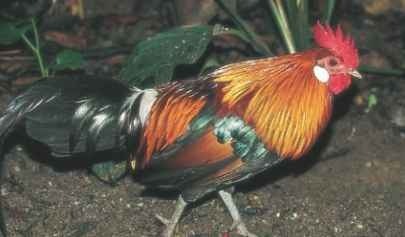
BEHAVIOR
The red junglefowl has a complex social life. Although usually seen in small family parties, flocks of up to 50 birds may assemble outside the breeding season. Mature males split away from these flocks to form loose bachelor groups while they molt their breeding plumage.
Life in both groups is governed by a hierarchy known as the pecking order, in which each bird has its place according to its strength and character Dominant birds are able to claim the best feeding and roosting sites. Various challenges, from ritual posturing to fierce combat, are used to determine rank, but comparative peace reigns once the pecking order is established. Although bold among its own kind, the junglefowl is ready to run for cover at the slightest disturbance. It can fly to escape predators, such as leopard cats, but it is usually reluctant to take to the skies.
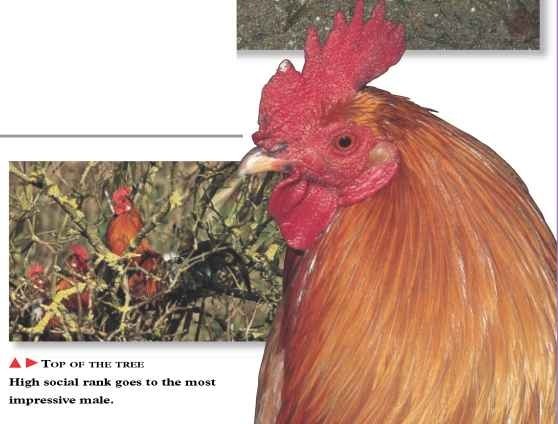
Profile
Red Junglefowl
Adorned with rich colors and fanciful feathers, the male red junglefowl uses his magnificent plumage to entice females during breeding season.
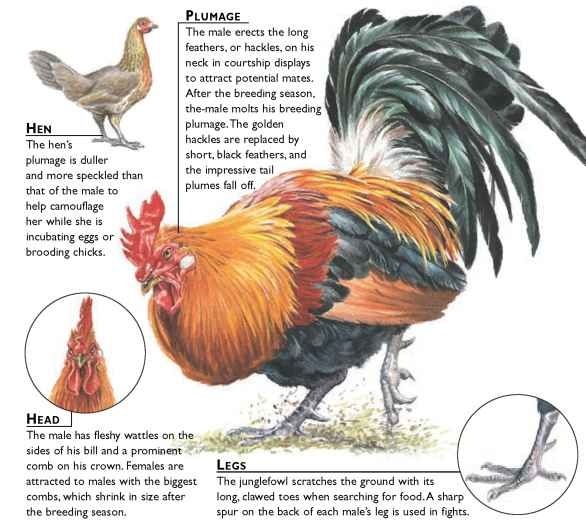
CREATURE COMPARISONS
Some I 50 breeds of poultry — from 8″-long bantams to giant I 5-lb. Brahma cockerels — have been developed since the red junglefowl was domesticated in 3200 BC. Various types have been used for religious purposes, cock-fighting, meat, eggs and exhibition. Breed names include Scots dumpy, Sicilian buttercup, and marsh daisy. A popular show variety is the black-red modern game bantam, which despite its name, has existed for over 100 years. Smaller than the red junglefowl, it has long legs, a slender body and no comb or wattles.
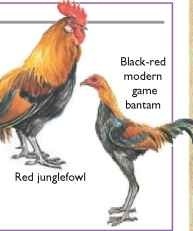
| VITAL | |
| STATISTICS | |
| Weight | Male 24-51 oz.; female 17-37 oz. |
| Length | Male 26-30″; female 17-18″ |
| Wingspan | Male 26-32″; female 14-25″ |
| Sexual Maturity | 1 year |
| 8 Breeding Season |
Dry season |
| KMJMBER Eggs |
4-9, but usually 5 or 6 |
| Incubation Period | 18-20 days |
| Fledging Period | Flies at 6-7 days; on its own j at 45-60 days |
| Typical Diet | Seeds, grain, shoots, roots, fruit and insects |
| Lifespan | 3 years |
RELATED SPECIES
• The red junglefowl is I of 48 species of pheasant in the family Phasianidae, which includes 3 pther junglefowls: the Ceylon junglefowl, Gallus lafayetii, the-gray junglefowl, G.-sonneratii, and the green junglefowl, G.-varius (below).
